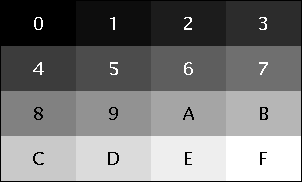Appendix F
© 1995, 1996, 1997 Gregg M. Townsend, Ralph E. Griswold, and Clinton
L. Jeffery
Palettes
Palettes are predefined sets of colors that are used with DrawImage().
Palettes also can be used to limit the colors used by ReadImage().
This appendix documents the contents of Icon's palettes and serves as a
reference for the programmer. It is hard, though, to understand a palette
just by reading about it. The program palette, which displays
and labels the colors of the palette, provides a clearer introduction.
Grayscale Palettes
The g16 palette, shown below, provides 16 shades of gray specified
by the hexadecimal characters 0123456789ABCDEF, with 0
being black and F being white in accordance with the usual
conventions of image processing.

Actually, g16 is just one member of a family of palettes named
g2 through g64, each providing the corresponding
number of equally spaced shades from black to white. Each gn
palette uses the first n characters of this list:
0123456789ABCXYZabcxyz{}
In every case 0 is black and the rightmost character is white.
For palettes with more than 64 entries, it becomes more difficult and eventually
impossible to stay within the printable characters. The remaining grayscale
palettes, g65 through g256, use the first n
characters of &cset instead of the list above.
The c1 Palette
The palette c1 is designed for constructing color images by
hand. It is defined using the Icon color-naming system by the table below.
hue deep dark medium light pale weak
black 0
gray 1 2 3 4 5
white 6
brown ! p ? C 9
red n N A a # @
orange o O B b $ %
red-yellow p P C c & |
yellow q Q D d , .
yellow-green r R E e ; :
green s S F f + -
cyan-green t T G g * /
cyan u U H h ` '
blue-cyan v V I i < >
blue w W J j ( )
purple x X K k [ ]
magenta y Y L l { }
magenta-red z Z M m ^ =
pink 7
violet 8
Note that in the Icon color naming system, "dark brown"
and "light brown" are the same as two shades of red-yellow.
Uniform Color Palettes
Programs that compute images can more easily use a palette having RGB colors
that are in some sense "equally spaced". The c3,
c4, c5, and c6 palettes are designed
with this in mind, and the c2 palette can also be considered
part of this family. The larger palettes allow better color selection and
subtler shadings but use up more of the limited number of simultaneous colors.
For any of these cn palettes, the palette provides n
levels of each RGB primary color; letting m = n - 1, these
levels range from 0 (off) to m (full on). The palette also provides
all the colors that can be obtained by mixing different levels of the primaries
in any combination. Mixing equal levels produces black (0,0,0), white (m,m,m),
or a shade of gray. Mixing unequal levels produces colors.
Each cn palette also provides (n - 1)^2 additional
shades of gray to allow better rendering of monochrome images. n
- 1 intermediate shades are added in each interval created by the original
n regular achromatic entries, giving a total of n^2 - n
+ 1 grayscale entries.
The lists below specify the characters used by each palette. The n
^3 regular entries are ordered from (0,0,0) to (m,m,m),
black to white, with the blue component varying most rapidly and the red
component varying most slowly. These are followed in the right column by
the additional shades of gray from darkest to lightest.
c2: kbgcrmyw x
c3: @ABCDEFGHIJKLMNOPQRSTUVWXYZ abcd
c4: 0123456789ABC ... XYZabc ... wxyz{} $%&*-/?@
c5: \000\001 ... yz{| }~\d\200\201 ... \214
c6: \000\001 ... \327 \330\331 ... \360
For example, the regular portion of the c3 palette is interpreted
this way:
char. r g b char. r g b char. r g b
@ 0 0 0 I 1 0 0 R 2 0 0
A 0 0 1 J 1 0 1 S 2 0 1
B 0 0 2 K 1 0 2 T 2 0 2
C 0 1 0 L 1 1 0 U 2 1 0
D 0 1 1 M 1 1 1 V 2 1 1
E 0 1 2 N 1 1 2 W 2 1 2
F 0 2 0 O 1 2 0 X 2 2 0
G 0 2 1 P 1 2 1 Y 2 2 1
H 0 2 2 Q 1 2 2 Z 2 2 2
The complete set of grayscale entries in c3, merging regular
and extra entries, is @abMcdZ (from black to white).
The sizes of c5 and c6 require that they include
some nonprinting characters, so they are better suited for computed images
than direct specification.
Back to Contents
